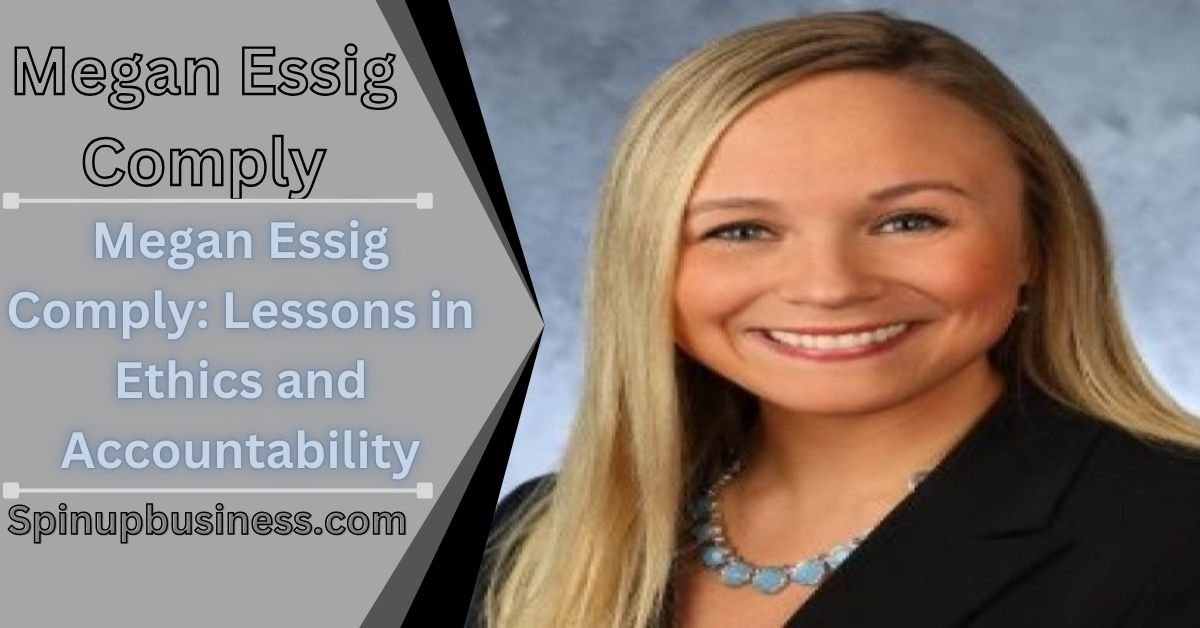Introduction to the Megan Essig Comply Scandal
The name Megan Essig Complyhas become synonymous with a significant scandal that shook the foundations of corporate ethics. As details emerged about the Comply program, it became clear that this was more than just a case of mismanagement; it was a wake-up call for businesses everywhere. How did we find ourselves in such a predicament? The story unfolds like a cautionary tale, revealing critical lessons on ethics and accountability that every organization must take to heart.
In an age where transparency is paramount, the fallout from this controversy has sparked conversations about integrity in the workplace. Employees and stakeholders are left questioning what went wrong—and how future generations can avoid similar pitfalls. As we dive into these important themes, it’s essential to recognize what happened and what can be done moving forward.
Join us as we explore the impact of this case and uncover valuable insights for fostering a culture grounded in ethical leadership and responsibility.
What is the Comply program?
The Comply program was designed as a comprehensive framework for ensuring regulatory adherence in corporate environments. Its primary aim is to streamline compliance processes and mitigate risks associated with legal and ethical breaches.
At its core, the program emphasizes transparency and accountability. It provides employees with clear guidelines on acceptable behaviours and practices. Training modules are often part of this initiative, educating staff on regulatory requirements specific to their industry.
Additionally, the Comply program incorporates regular audits to assess compliance levels across teams. This proactive approach helps identify areas needing improvement before they escalate into larger issues.
It serves as a company safeguard and a commitment to ethical conduct in business operations. The focus remains on creating an environment where integrity thrives alongside productivity.
The role of ethics and accountability in the workplace
Ethics and accountability serve as the backbone of a thriving workplace. They create an environment where trust flourishes, fostering open communication among employees.
Individuals who feel responsible for their actions are more likely to make decisions that align with company values. This sense of ownership boosts morale and enhances collaboration across teams.
Moreover, ethical behaviour mitigates risks associated with misconduct. It helps prevent scandals that can tarnish reputations and disrupt business operations.
Accountability also means holding leaders to high standards. When management prioritizes ethics, it sets a powerful example for everyone in the organization. Employees take cues from their leaders; when they see integrity in action, they’re inspired to mirror those behaviours.
Integrating ethics into daily practices enhances performance and strengthens organizational culture. The benefits extend far beyond compliance; they pave the way for sustained success.
Lessons learned from the Megan Essig Comply case
The Megan Essig Comply case serves as a stern reminder of the consequences of ethical lapses. It highlights how quickly trust can erode when accountability is absent.
One critical lesson is the importance of transparency. Open communication fosters an environment where employees feel safe to voice concerns without fear of retaliation.
Another takeaway is the necessity for robust training programs. Regular ethics training ensures all team members understand company values and expected behaviours.
Leadership plays a pivotal role in shaping company culture. When leaders act with integrity, it sets a standard for everyone else to follow.
This case reinforces that ethics isn’t just a box to check; it’s foundational for sustainable success in any organization.
How companies can prevent similar scandals and cultivate a culture of integrity
Companies must prioritize transparency to prevent scandals like the Megan Essig Comply case. Open communication channels foster trust and encourage employees to voice concerns without fear.
Implementing robust compliance training is crucial. Regular sessions keep ethics at the forefront of employee minds, reinforcing expected behaviours and decision-making processes.
Encouraging accountability among all levels of staff can also make a difference. When everyone understands their role in upholding company values, it cultivates a sense of shared responsibility.
Leadership commitment plays a vital role, too. Leaders should model ethical behaviour consistently, as actions often speak louder than words. This sets the tone for an organization’s culture.
Additionally, establishing anonymous reporting mechanisms allows employees to raise red flags discreetly. Knowing they have a safe outlet encourages vigilance against unethical practices.
Regular audits and assessments help identify areas for improvement before issues escalate into scandals or crises.
Impact on employees and stakeholders
The fallout from the Megan Essig Comply scandal was felt deeply across the organization. Employees found themselves wrestling with trust issues with their leadership and colleagues. Morale took a hit as uncertainty replaced confidence in company values.
Stakeholders were not immune to this turmoil. Investors watched closely, reassessing their positions amid fears of reputational damage and potential financial loss. The ripple effect reached clients, too; many questioned whether they could continue partnerships built on shaky ethical ground.
As employees grappled with these challenges, some chose to leave, seeking workplaces aligned more closely with their values. Others stayed but became disillusioned, impacting productivity and collaboration within teams.
This scenario highlights how interconnected integrity is to every level of an organization—shaping culture, employee loyalty, and stakeholder relationships.
The importance of ethical leadership in business success
Ethical leadership is the backbone of any successful organization. When leaders prioritize integrity, they set a tone that resonates throughout the company. Employees feel valued and respected, fostering loyalty and commitment.
Trust becomes a vital currency in business relationships. Ethical leaders inspire teams to act responsibly, making decisions that align with shared values. This sense of purpose drives performance and innovation.
Moreover, ethical practices attract customers seeking brands aligned with their values. Companies known for strong ethical standards enjoy better reputations and increased customer loyalty.
Organizations led by ethical visionaries are more resilient during crises. A foundation built on trust allows companies to navigate challenges with transparency and fortitude, safeguarding profit margins and stakeholder interests.
Conclusion:
The fallout from the Megan Essig Comply scandal is a powerful reminder of the critical importance of ethics and accountability in any organization. It highlights that even well-intentioned programs can be mismanaged, leading to significant consequences for employees and stakeholders.
In today’s business landscape, integrity should not just be an afterthought; it must be woven into the company’s culture. Organizations need to prioritize ethical leadership at all levels. Leaders who model accountability and transparency inspire their teams to do the same.
The lessons learned from this case are invaluable for companies aiming to foster trust and commitment among their workforce. By taking proactive steps towards creating ethical frameworks, businesses can protect themselves from potential scandals while enhancing their reputation in the marketplace.
As we move forward, let this serve as a pivotal moment for organizations everywhere—where cultivating a robust ethical foundation is non-negotiable for long-term success.

Zoe Rae is a dynamic writer at SpinUpBusiness.com, where she covers a broad range of topics from business strategies to lifestyle, technology, and more. With a keen eye for detail and a passion for making complex ideas simple, Zoe crafts content that informs, engages, and inspires her readers.



